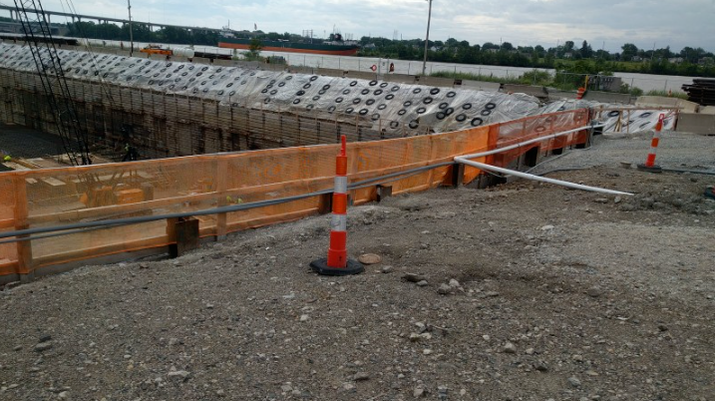Comprehensive Geotechnical Works to Guarantee Website Stability
Comprehensive Geotechnical Works to Guarantee Website Stability
Blog Article
How Consulting Engineers Enhance Geotechnical Engineering Projects: Insights Into Their Competence, Approaches, and Collaborative Approaches
Consulting engineers are pivotal in improving geotechnical design jobs, applying their specialized knowledge to browse the intricacies of subsurface problems. Their collaborative strategies foster interaction amongst varied job stakeholders, eventually shaping the task's trajectory.
Function of Consulting Engineers
The competence of consulting engineers in geotechnical design is fundamental to the successful implementation of construction tasks. These professionals play an essential role in assessing dirt and rock residential or commercial properties, which are important elements influencing layout and construction choices. By carrying out complete site investigations, seeking advice from engineers gather vital information that educates the style procedure, making certain tasks are constructed on secure and ideal ground.
Consulting designers also provide very useful insights right into risk management (geotechnical geologist). They recognize prospective geotechnical dangers, such as landslides, soil liquefaction, and negotiation issues, enabling stakeholders to apply reliable reduction methods. Their expertise aids in optimizing structure styles, which can bring about substantial expense financial savings and enhanced safety
Additionally, speaking with designers work as a crucial web link between task owners, designers, and professionals. Their ability to translate complicated geotechnical information right into actionable suggestions fosters cooperation and promotes educated decision-making throughout the job lifecycle. This multidisciplinary strategy not only enhances task efficiency yet likewise ensures compliance with regulatory requirements and ideal techniques.
Trick Methods in Geotechnical Design

One main technique is website investigation, which entails conducting field examinations and lab analyses to collect information on subsurface conditions. Strategies such as Standard Penetration Screening (SPT) and Cone Penetration Testing (CPT) are commonly utilized to examine dirt stratigraphy and toughness. Furthermore, geophysical techniques, including seismic and electrical resistivity studies, supply non-invasive means to evaluate subsurface features.
An additional essential methodology is numerical modeling, which allows engineers to simulate different circumstances and predict just how soil-structure communications will certainly behave under various loading problems. Limited Element Analysis (FEA) is a typical strategy employed in this context.
In addition, the style of structures, preserving frameworks, and earthworks relies heavily on these methods - geotechnical geologist. By integrating advanced analytical tools with area information, getting in touch with designers can develop customized solutions that resolve particular project obstacles, ultimately adding to the stability and security of building tasks
Value of Soil Analysis
Dirt analysis functions as a foundational aspect in geotechnical design, providing essential insights right into the physical and chemical residential properties of dirt required for reliable building planning. Understanding dirt qualities is crucial for establishing its load-bearing capacity, water drainage actions, and potential for settlement or instability. Thorough dirt examinations, consisting of tasting and research laboratory testing, aid identify specifications such as soil kind, wetness material, thickness, and shear strength.
These analyses inform the choice of ideal building and construction techniques and materials, ultimately influencing task safety and security and durability. Cohesive soils may need various foundation styles compared to granular soils, demanding tailored engineering services. Moreover, dirt analysis help in determining contaminants that could pose dangers to human health and wellness or the environment, permitting the advancement of mitigation techniques.
Integrating dirt evaluation into the beginning of project development helps to lessen unforeseen obstacles, ensuring that engineers can prepare for and deal with possible problems before they escalate. By establishing a comprehensive understanding of the site problems, getting in touch with engineers can optimize design effectiveness and decrease prices, therefore improving the total success of geotechnical design jobs.
Collective Methods in Jobs
Effective geotechnical projects typically rest on next page joint strategies that bring with each other varied expertise from different self-controls. Reliable collaboration amongst seeking advice from designers, rock hounds, ecological scientists, and building experts is vital for resolving complicated obstacles and optimizing task outcomes. By leveraging the distinct abilities and understanding of each staff member, jobs can gain from an all natural understanding of the website problems, governing demands, and this content design restraints.
Routine communication and interdisciplinary conferences promote the sharing of insights and foster a culture of teamwork. These collaborative efforts enable the recognition of prospective threats early in the job lifecycle, enabling timely reduction approaches. In addition, including feedback from stakeholders, consisting of regional areas and regulative agencies, guarantees that all viewpoints are thought about, enhancing task approval and compliance.
Furthermore, the assimilation of sophisticated innovations, such as Geographic Info Systems (GIS) and Building Details Modeling (BIM), additional improves cooperation. These devices enable the real-time sharing of data and visualization of geotechnical conditions, advertising educated decision-making. Inevitably, a joint technique not just simplifies project implementation but also lays the foundation for innovative remedies to complicated geotechnical design obstacles.
Effect On Job End Results

Consulting engineers employ sophisticated approaches such as risk analysis and predictive modeling, which enhance the precision of project projections. Their ability to incorporate ingenious modern technologies, like geotechnical instrumentation and information analytics, even more fine-tunes the style and building and construction processes. As an outcome, jobs experience enhanced efficiency, reduced expenses, and decreased delays.
Additionally, fostering reliable interaction and cooperation among team members enhances analytical capabilities. When difficulties occur, an unified front enables quick recognition of services, preventing potential setbacks. Inevitably, the collective initiatives of getting in touch click over here with engineers add to greater high quality results, ensuring that projects satisfy both governing criteria and client expectations.
Conclusion

Report this page